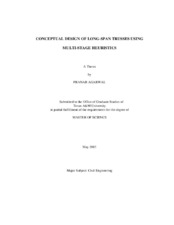| dc.description.abstract | A hybrid method that addresses the design and optimization of long-span steel trusses is presented. By utilizing advancements in present day computing and biologically inspired analysis and design, an effort has been made to automate the process of evolving optimal trusses in an unstructured problem domain. Topology, geometry and sizing optimization of trusses are simultaneously addressed using a three stage methodology. Multi-objective genetic algorithms are used to optimize the member section sizes of truss topologies and geometries. Converting constraints into additional objectives provides a robust algorithm that results in improved convergence to the pareto-optimal set of solutions. In addition, the pareto-curve plotted based on how well the different objectives are satisfied helps in identifying the trade-offs that exist between these objectives, while also providing an efficient way to rank the population of solutions during the search process. A comparison study between multi-objective genetic algorithms, simulated annealing, and reactive taboo search is conducted to evaluate the efficiency of each method with relation to its overall performance, computational expense, sensitivity to initial parameter settings, and repeatability of finding near-global optimal designs. The benefit of using a three stage approach, and also implementing the entire model on parallel computers, is the high level of computational efficiency that is obtained for the entire process and the near-optimal solutions obtained. The overall efficiency and effectiveness of this method has been established by comparing the truss design results obtained using this method on bridge and roof truss benchmark problems with truss designs obtained by other researchers. One of the salient features of thisresearch is the large number of optimal trusses that are produced as the final result. The range of designs available provides the user with the flexibility to select the truss design that best matches their design requirements. By supporting human-computer interactions between these stages, the program also incorporates subjective aesthetic criteria, which assist in producing final designs in consonance with the user's requirements. | en |


